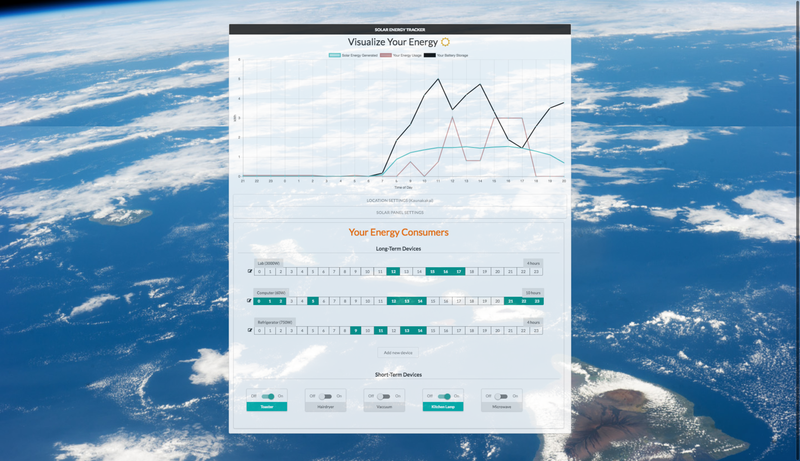Powered by Sunshine | You are my Sunshine
Awards & Nominations
Powered by Sunshine has received the following awards and nominations. Way to go!
The Challenge | You are my Sunshine
Powered By Sunshine!
PBS helps users understand and visualize simulated real-time solar data and serves as a platform for planning electrical device usage.

INSPIRATION
Powered By Sunshine is designed to help users around world become more sustainable and more aware of their energy usage throughout the day. Through our application, we hope that users can better understand how much energy can be generated from their solar panels at a specific location, and become inspired to change their electronic device usage in ways that utilize energy efficiently and are cost effective.
DESCRIPTION
Powered By Sunshine (PBS) is an interactive web application that can be accessed anywhere--from a phone, tablet, or computer. Users can input their location (or grab their location by GPS), and input information about their solar panels, such as solar panel area, solar panel absorption, and solar battery capacity. Using this information, PBS gathers external weather and sun radiation data to estimate hourly solar energy generation during the next 24 hours. Users can then add and edit their electronic devices (name and wattage), and use the simple user interface to select which times of the day they would like to use their devices. All of this data can be visualized easily on the main graph, which allows users to see: during which times of the day their panels are generating the most energy, how much energy is being generated, which times of the day are using energy from the panels, battery, or grid, and which times of the day have wasted solar energy that goes unused and sent back to the grid. Users can choose view their data with simple statistics as well--showing users things like how much money they are saving, and where their power is currently coming from. With this data, users can play around with altering their device usage to find the most ideal usage patterns that use solar energy effectively, save money, and work around their personal schedules.
PBS could be used by anyone with solar panels--homeowners, personal portable solar device owners, or researchers such as those at HI-SEAS. We contacted some of the researchers at HI-SEAS and discovered that they gather and save their solar energy data and use relatively low-tech solutions (i.e. spreadsheets) to estimate things like future device usage and future solar energy production. We hope that Powered By Sunshine could provide a more convenient tool for researchers and casual solar energy users to better understand the effect that solar energy can have on their every day life.
RESOURCES
- Natural Renewable Energy Laboratory (NREL)
- Open Weather Map
- Meteor Framework
- Semantic UI
- Materialize CSS
- Chart.js
CHALLENGES FACED
Design
We went through several different designs before we ended up with the current application. We all had different ideas about how we wanted to display the data, and it was difficult to decide which design would be the most simple and intuitive while still representing the most important information. We finally decided to focus on displaying generated, consumed, and stored solar energy per hour on a line graph to illustrate points of interest such as when there is a large gap between the energy generated and how much you're actually using. We also made the visualization update in real-time and made sure to always project 24 hours in the future so users could plan ahead.
data
Our app updates using real-time radiation and weather data. We were easily able to gather weather data from Open Weather Map API but the most recent solar data we could find was from 2005 NREL data sets. Our approach to getting the most accurate representation of current sun radiation was to get the max radiation for the current hour across 30 days (+-15 days), with the ideal being a day with 0 cloud coverage. We then layered real-time weather data on top to generate what we thought was a good representation of how much radiation a certain location would be getting without the need for users to purchase expensive hardware.
SpaceApps is a NASA incubator innovation program.